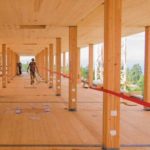Carbon Sequestration
Posted: December 28, 2017Source: Building Construction Design
Locking up carbon and unlocking the full potential of timber

Courtesy ofStructurlam
We may commonly hear the term ‘carbon sequestration’ but what does it actually mean? The dictionary definition of sequestration is ‘isolated and hidden away’. To put it simply, it is the process of capture and long-term storage of atmospheric carbon dioxide (CO2). Within the built environment there are often discussions focused on operational carbon emissions in relation to the environmental impact of building but not necessarily sequestered carbon. Greg Cooper, Pre-Construction Manager of the X-LAM Alliance, speaks about the positive impact of cross laminated timber (CLT) on carbon sequestration within the built environment:
“According to the research conducted by Wood for Good, there are two ways to decrease CO2 in the atmosphere – either by reducing emissions, or by removing CO2 and storing it. Wood has the unique ability to do both.
Carbon sequestration describes long-term storage of carbon dioxide or other forms of carbon to either mitigate or defer global warming and avoid dangerous climate change. This is an extremely complex process that has taken mankind centuries to mimic. The latest technological advances have made it possible to take carbon dioxide out of the air via mechanical processes and store it deep underground, but this is only a recent innovation.
Something as simple as planting a tree can sequester carbon. Trees use photosynthesis to take carbon dioxide out of the air and transform it into sugars which it uses to sustain and grow. Sequestration of carbon dioxide by trees from the atmosphere equates to approximately 900kg of CO2 per cubic meter of wood, which it holds captive during its entire lifetime, even when it is reprocessed in the form of a building. The amount of carbon sequestered in a forest can be increased via forest management and reforestation, which involves replanting trees to replace those cut down for timber to increase the carbon density of a pre-existing forest. Commercially managed woodland locks down one third more CO2 than wild forest woodland. Globally, forests could provide abatement to about 25% of current emissions by 2030 through reduced deforestation, forest management and afforestation.
There is an ongoing requirement and government responsibility to decarbonise the national grid by 2050. This involves reducing the operational energy required for the heating and lighting of a building. When considering the whole life carbon of buildings, the embodied energy forms a significant part. Reducing the levels of embodied carbon is critical and can be achieved through the application of structural timber technology.
Solid wood products such as cross laminated timber (CLT) are natural, renewable and are far less energy-intensive to produce and apply than alternative materials. When compared to other building materials such as concrete or steel, the environmental credentials of CLT are far superior. Not only is it a renewable material, it involves very little waste during production and is extremely carbon efficient to transport. When we consider the whole manufacturing processes for the production of each m3 of CLT, -676kg of CO2will still be stored after the production process.
Due to the woods sequestration of CO2, the overall carbon footprint for a CLT building is lowered by up to 75%. To put into context the extent of the benefits of CLT – a typical timber house has the ability to lock up 19 tonnes of CO2, meaning that if the government were to hit their target of building 200,000 homes per year – but only using timber frame methods – this would mean an extra -3.81million tonnes of CO2 sequestered and stored every year. It is believed that a single five-storey, cross laminated timber building is able to cut emissions by levels equivalent to removing as many as 600 cars from the road for a year.
The recent development of advanced CLT products, has allowed developers to build in excess of 10 storey buildings from timber. This is of extreme benefit in urban areas that are constantly looking to reduce their carbon footprint. The carbon stored in the panels of these buildings help to offset the greenhouse gases that are released during the production of other building materials and in the construction of the build.
With timber supply being one of very few truly global industries, it is important to constantly enable the expansion of the sector in order to meet demand through sustainable and ecological practices. Potential benefits of lower carbon construction, job creation and reforestation through the consideration of sequestered carbon are crucial. The X-LAM Alliance use only PEFC and FSC® certified timber – demonstrating commitment to the promotion of environmentally appropriate, socially beneficial and economically viable management of the world’s forests. This ensures that timber products are produced with respect for the highest ecological, social and ethical standards.
UK partner of the X-LAM Alliance, B & K Structures, have taken carbon sequestration to the next level through the creation of the carbon calculator. This advanced tool has offset carbon used to cultivate and manufacture the engineered timber against publically available specification, to create a robust and genuine guide to give our clients an informed choice on the carbon values of the materials available.
One of the X-LAM Alliances latest projects, Dalston Lane, is set to be the world’s tallest residential timber structure. The project is a new 10 storey cross laminated timber scheme consisting of a basement/first floor in concrete frame with the remaining storeys in 4489m³ of laminated timber. The cross laminated timber in this project alone will create a carbon sink 3034 tonnes of CO₂e even after energy used during manufacture has been taken into account.
It is clear that the timber industry plays a huge part in our environmental and building heritage. If we want to tackle the issue of global warming, we must embrace the benefits of this age old building material and recognise it is a vital part of our low-carbon future.”
